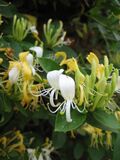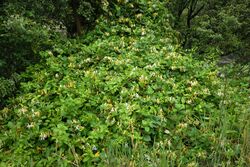Biology:Lonicera japonica
| Lonicera japonica | |
|---|---|

| |
| Scientific classification | |
| Kingdom: | Plantae |
| Clade: | Tracheophytes |
| Clade: | Angiosperms |
| Clade: | Eudicots |
| Clade: | Asterids |
| Order: | Dipsacales |
| Family: | Caprifoliaceae |
| Genus: | Lonicera |
| Species: | L. japonica
|
| Binomial name | |
| Lonicera japonica | |
| Synonyms[1] | |
| |
Lonicera japonica, known as Japanese honeysuckle[2] and golden-and-silver honeysuckle,[3] is a species of honeysuckle native to eastern Asia, including many parts of China. It is often grown as an ornamental plant, but has become an invasive species in a number of countries. Japanese honeysuckle is used in traditional Chinese medicine.
Description
Lonicera japonica is a twining vine[4] able to climb up to 10 m (33 ft) high or more in trees, with opposite, simple oval leaves 3–8 cm (1.2–3.1 in) long and 2–3 cm (0.79–1.18 in) broad. When its stems are young, they are slightly red in color and may be fuzzy. Older stems are brown with peeling bark, and are often hollow on the inside.[5]
The flowers are double-tongued, opening white and fading to yellow, and sweetly vanilla scented. The fruit, which is produced in fall,[5] is a black spherical berry 3–4 mm (0.12–0.16 in) diameter containing a few seeds.[6] While the nectar from the flowers can be safely consumed by humans, all other parts of the plant have the potential to be toxic.[7]
Subspecies
There are three subspecies of Lonicera japonica:
| Image | Subspecies | Description | Distribution |
|---|---|---|---|
 |
Lonicera japonica var. chinensis (P.Watson) Baker | Corolla purple outside, white inside. Usually diploid 2n=18 | China (Anhui, 安徽省 in Chinese) around 800 meters[8] |
 |
Lonicera japonica var. japonica | Vigorous vine, Corolla white, later yellow-white. Usually diploid 2n=18 | Grows on the edge of forest in China, Japan, and Korea[9] |
| Lonicera japonica var. miyagusukiana Makino | Tetraploid with chromosome number of 2n=36 | Found in tops of exposed windy limestone cliffs in Ryukyus Islands, Japan[10] |
Cultivation, management, and uses
Even though it is a highly invasive and destructive plant,[11] this species is often sold by American nurseries as the cultivar 'Hall's Prolific' (Lonicera japonica var. halliana),[citation needed] and in the UK as the cultivar 'Halliana'. The cultivar is also known as Hall's Japanese honeysuckle.[12] It is an effective groundcover and has strong-smelling flowers. It can be cultivated by seed, cuttings, or layering. In addition, it will spread itself via shoots if given enough space to grow. The variety L. japonica var. repens[13] has gained the Royal Horticultural Society's Award of Garden Merit.[14]
Japanese honeysuckle flowers are edible to humans and appreciated for their sweet-tasting nectar. The flowers can also be a significant source of food for deer, rabbits, hummingbirds, and other wildlife.[15]
Herbal medicine
In traditional Chinese medicine,[16] Lonicera japonica is called rěn dōng téng (忍冬藤);[16] literally "winter enduring vine") or jīn yín huā[16] (Chinese: 金銀花; literally "gold-silver flower", in reference to the presence of flowers of different age on the same plant as each flower change from white (silver) to yellow (gold)).[citation needed] Alternative Chinese names include er hua (二花) and shuang hua (雙花), meaning double-[color] flowers.[17]
The dried leaves and flowers (Flos Lonicerae Japonicae) are employed in traditional Chinese medicine, where they are believed to be of use to treat fever, cold-related headache, cough, thirst, certain inflammation including sore throat, skin infection, and tumor necrosis.[18]
Antiviral action
The antiviral action of loniflavone, a compound found in Lonicera japonica, has been investigated in computational studies, in which the ability of this compound to bind with high affinity to the spike protein of SARS-CoV-2 has been demonstrated, an early step towards drug development for the disease caused by that virus.[19]
As an invasive species
Japanese honeysuckle has become naturalized in Argentina, Australia, Brazil, Mexico, New Zealand, and much of the US, including Hawaii, as well as a number of Pacific and Caribbean islands. It is classified as a noxious weed in Texas,[20] Illinois, and Virginia, and is banned in Indiana[21] and New Hampshire.[22] It is listed on the New Zealand National Pest Plant Accord as an unwanted organism.[23]
Lonicera japonica was initially brought to the United States from Japan in the early 1900s as an ornamental plant. It is still deliberately planted in the United States for reasons such as erosion control or forage for deer, but has become invasive in many areas.[5] It prefers to invade areas that have been disturbed, such as roadsides or floodplains. It will generally only invade forests when the canopy has been opened by logging or fallen trees, as it grows less vigorously in the shade.[24] Once it has invaded an area, Lonicera japonica grows rapidly and outcompetes native plants for sunlight and nutrients.[5] It proliferates using both sexual and vegetative reproduction, producing seeds that are spread by animals and expanding locally via rhizomes.[25] Eventually, it will form a dense thicket which prevents other plant species from germinating in that area.[5] Due to its suppression of germination in the understory, Lonicera japonica also prevents the regeneration of trees.[26]
Management of invasive Lonicera japonica has been achieved through a variety of means. Small patches can be removed by hand, or using simple digging tools,[25] but all plant parts including roots and rhizomes must be removed to prevent resprouting.[5] Larger patches can be removed through repeated mowing, but application of herbicide is also recommended to prevent regrowth.[25] There has been some study of using controlled burns to remove Lonicera japonica, but the underground portion of the plant is usually able to survive and resprout, limiting the effectiveness of this method.[5] Browsing by herbivores may limit its growth, but is unlikely to fully eliminate it.[26] There is currently no known biological control for Lonicera japonica.[25]
Chemistry
Lonicera japonica contains methyl caffeate, 3,4-di-O-caffeoylquinic acid, methyl 3,4-di-O-caffeoylquinate, protocatechuic acid, methyl chlorogenic acid, and luteolin. The two biflavonoids, 3′-O-methyl loniflavone and loniflavone, along with luteolin and chrysin, can be isolated from the leaves.[27] Other phenolic compounds present in the plant are hyperoside, chlorogenic acid, and caffeic acid.[28] The two secoiridoid glycosides, loniceracetalides A and B, can be isolated, together with 10 known iridoid glycosides, from the flower buds.[29] The plant also contains the saponins loniceroside A and B[30] and the anti-inflammatory loniceroside C.[31]
References
- ↑ "The Plant List: A Working List of All Plant Species". http://www.theplantlist.org/tpl1.1/record/kew-2339716.
- ↑ (xls) BSBI List 2007, Botanical Society of Britain and Ireland, https://bsbi.org/download/3542/, retrieved 2014-10-17
- ↑ English Names for Korean Native Plants. Pocheon: Korea National Arboretum. 2015. pp. 525. ISBN 978-89-97450-98-5. http://www.forest.go.kr/kna/special/download/English_Names_for_Korean_Native_Plants.pdf. Retrieved 4 January 2017.
- ↑ Watts, D. C. (2007-05-02) (in en). Dictionary of Plant Lore. Academic Press. ISBN 9780080546025. https://books.google.com/books?id=WAagnZNb0cAC.
- ↑ 5.0 5.1 5.2 5.3 5.4 5.5 5.6 "Lonicera japonica – UF/IFAS Center for Aquatic and Invasive Plants". https://plants.ifas.ufl.edu/plant-directory/lonicera-japonica/.
- ↑ "Flora of Taiwan: Lonicera japonica". http://tai2.ntu.edu.tw/udth/bin/fot1.exe/browse?BID=4&page=744.
- ↑ "Lonicera japonica (Hall's Honeysuckle, Japanese Honeysuckle) | North Carolina Extension Gardener Plant Toolbox". https://plants.ces.ncsu.edu/plants/lonicera-japonica/.
- ↑ "Lonicera japonica var. chinensis in Flora of China @ efloras.org". http://www.efloras.org/florataxon.aspx?flora_id=2&taxon_id=200022325.
- ↑ "Lonicera japonica var. japonica in Flora of China @ efloras.org". http://www.efloras.org/florataxon.aspx?flora_id=2&taxon_id=242330396.
- ↑ Denda, Tetsuo; Koja, Arisa; Yokota, Masatsugu (2007). "Chromosomal studies of insular endemicLonicera japonicaThunb. var.miyagusukianaMakino (Caprifoliaceae) in the Ryukyu Archipelago of Japan". Caryologia (Informa UK Limited) 60 (4): 331–337. doi:10.1080/00087114.2007.10797956. ISSN 0008-7114.
- ↑ "Japanese Honeysuckle (Lonicera japonica)". https://www.invasive.org/alien/pubs/midatlantic/loja.htm.
- ↑ "Lonicera japonica 'Halliana'". Royal Horticultural Society. https://www.rhs.org.uk/Plants/93277/Lonicera-japonica-Halliana/Details.
- ↑ "RHS Plant Selector – Lonicera japonica var. repens". http://apps.rhs.org.uk/plantselector/plant?plantid=1188.
- ↑ "AGM Plants – Ornamental". Royal Horticultural Society. July 2017. p. 61. https://www.rhs.org.uk/plants/pdfs/agm-lists/agm-ornamentals.pdf.
- ↑ Forest Plants of the Southeast and Their Wildlife Uses, James H. Miller and Karl V. Miller, University of Georgia Press, Revised Ed. 2005, p.278
- ↑ 16.0 16.1 16.2 Shang, X.; Pan, H.; Li, M.; Miao, X.; Ding, H. (2011). "Lonicera japonica Thunb.: Ethnopharmacology, phytochemistry and pharmacology of an important traditional Chinese medicine". Journal of Ethnopharmacology 138 (1): 1–21. doi:10.1016/j.jep.2011.08.016. PMID 21864666.
- ↑ Chinese Medical Herbology and Pharmacology, John and Tina Chen, Art of Medicine Press, 1st ed. 2001, p. 171
- ↑ Bensky, Dan; Barolet, Randall. Chinese Herbal Medicine Formulas & Strategies (2nd ed.). Eastland Press. p. 44.
- ↑ Kadioglu, Onat; Saeed, Mohamed; Greten, Henry Johannes; Efferth, Thomas (June 2021). "Identification of novel compounds against three targets of SARS CoV-2 coronavirus by combined virtual screening and supervised machine learning". Computers in Biology and Medicine 133: 104359. doi:10.1016/j.compbiomed.2021.104359. PMID 33845270.
- ↑ "Lonicera japonicaJapanese honeysuckle". http://www.texasinvasives.org/plant_database/detail.php?symbol=LOJA.
- ↑ "DNR: Terrestrial Invasive Species - Plants". https://www.in.gov/dnr/6351.htm.
- ↑ "Fact Sheet: Prohibited Invasive Plant Species Rules, Agr 3800". https://www.in.gov/dnr/6351.htm.
- ↑ "Species list" (in en). https://www.agriculture.nh.gov/publications-forms/documents/prohibited-invasive-species.pdf.
- ↑ "Maine Natural Areas Program, Invasive Plants, Japanese Honeysuckle". https://www.maine.gov/dacf/mnap/features/invasive_plants/lonicera_japonica.htm.
- ↑ 25.0 25.1 25.2 25.3 "Lonicera japonicaJapanese honeysuckle". http://www.texasinvasives.org/plant_database/detail.php?symbol=LOJA.
- ↑ 26.0 26.1 "Species: Lonicera japonica". https://www.fs.fed.us/database/feis/plants/vine/lonjap/all.html.
- ↑ Kumar, Neeraj; Singh, Bikram; Bhandari, Pamita; Gupta, Ajai P.; Uniyal, Sanjay K.; Kaul, Vijay K. (2005). "Biflavonoids from Lonicera japonica". Phytochemistry 66 (23): 2740–4. doi:10.1016/j.phytochem.2005.10.002. PMID 16293275.
- ↑ Peng, Youyuan; Liu, Fanghua; Ye, Jiannong (2005). "Determination of Phenolic Acids and Flavones in Lonicera japonica Thumb. By Capillary Electrophoresis with Electrochemical Detection". Electroanalysis 17 (4): 356. doi:10.1002/elan.200403102.
- ↑ Kakuda, Rie; Imai, Mio; Yaoita, Yasunori; Machida, Koichi; Kikuchi, Masao (2000). "Secoiridoid glycosides from the flower buds of Lonicera japonica". Phytochemistry 55 (8): 879–81. doi:10.1016/S0031-9422(00)00279-X. PMID 11140518.
- ↑ Ho Son, Kun; Young Jung, Keun; Wook Chang, Hyeun; Pyo Kim, Hyun; Sik Kang, Sam (1994). "Triterpenoid saponins from the aerial parts of Lonicera japonica". Phytochemistry 35 (4): 1005–8. doi:10.1016/S0031-9422(00)90656-3. PMID 7764625.
- ↑ Kwak, Wie Jong; Han, Chang Kyun; Chang, Hyeun Wook; Kim, Hyun Pyo; Kang, Sam Sik; Son, Kun Ho (2003). "Loniceroside C, an Anti-inflammatory Saponin from Lonicera japonica". Chemical & Pharmaceutical Bulletin 51 (3): 333–5. doi:10.1248/cpb.51.333. PMID 12612424.
Wikidata ☰ Q161083 entry
 |




